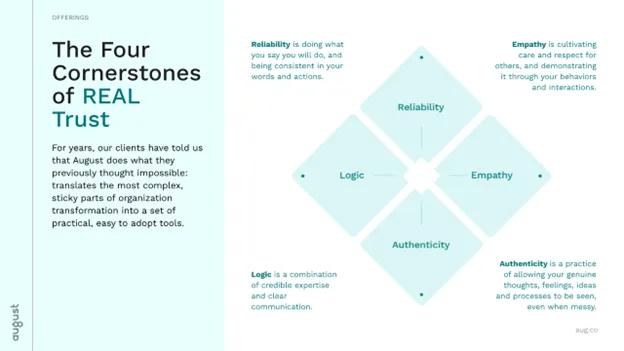ATD Blog
The Four Cornerstones of REAL Trust
Trust is a measurable cultural dynamic that can be strengthened through everyday practice.
Wed May 28 2025

When you think of building trust in your organization, the first things that might come to mind are trust falls, team building games, or sharing fun facts around a Zoom call.
There’s nothing wrong with these activities, of course (we love a good icebreaker!). But our work with large, complex organizations has taught us that successfully building organizational trust is as much about behaviors and actions as it is about creating familiarity and connection.
Take, for example, our firm’s recent partnership with a large software company at a critical inflection point. After some very public trust-eroding events, this organization sought our help in building trust from within. The goal was for each employee to become a trusted partner across internal teams, for their customers, and, by extension, to the broader communities they serve.
This organization rightly saw trust as a critical ingredient for organizational performance during an era of significant change.
By studying the work of Frances Frei and Anne Morriss, David Maister, Charles Feltman, and models like Edelman’s Trust Barometer, we were able to codify the buildable and measurable elements of trust that would help them in their mission.
So, what are these concrete factors for building trust? We distilled them into four cornerstones: Reliability, Empathy, Authenticity, and Logic (REAL).

Cornerstone #1: Reliability
Reliability is doing what you say you will do and being consistent in your words and actions. For leaders, it’s speaking and behaving in alignment with the organization’s values, so that your movements are consistent and predictable.
Reliability is built over time, through repeated behaviors and established patterns that teach people the specific ways they can depend on you.
When you follow through reliably, people learn to trust you with increasingly important tasks. This builds the organization’s capacity for innovation and growth.
Cornerstone #2: Empathy
Empathy is more than simply caring about people and sympathizing with their feelings. Empathy requires us to intentionally cultivate our own respect and support for others and demonstrate it through our behaviors and actions.
There are many ways you can demonstrate empathy in the workplace—for example, by genuinely seeking the ideas and expertise of others; showing that you value others by integrating those ideas in concrete, visible ways; delegating decision-making power to people close to the work; and investing time and energy in helping others succeed.
Cornerstone #3: Authenticity
Authenticity is the practice of allowing your genuine thoughts, feelings, ideas, and processes to be seen, even when messy. This takes vulnerability and courage, but authenticity allows us to do this in an empowered, candid way.
Authenticity can look like:
Sharing more deeply about ourselves. This includes what we value, what we struggle with, what we hope for, and more. This helps people get to know the “real us.”
Sharing our ideas and works in progress. This helps us release the pressure to maintain a “perfect” professional veneer and instead lean into genuine collaboration with our teams.
Being transparent and truthful by giving straight answers to reasonable questions, and sharing decisions and tradeoffs openly, rather than deflecting for fear of upsetting people.
Cornerstone #4: Logic
Logic is a combination of expertise and clear communication. A logical teammate understands their own work and skillfully communicates it to others. They convey complex information in a way that is intuitive and sensible. They set clear expectations and help everyone see how their work fits into the big picture.
Clear communication is one of the most effective ways to win people’s trust. You might have a breakthrough vision or a compelling plan, but if you can’t convey it clearly to others, trust in you and your plan will erode and eventually collapse.
Identifying Your Trust Anchor and Trust Wobble
Every organization and every individual can identify one cornerstone of trust they excel at and leverage above all others. This, as Frances Frei and Anne Morriss put it, is your trust anchor. Similarly, everyone has a trust wobble—a cornerstone you tend to overlook or underuse.
For example:
Reliability Anchor: You’re known for always following through on your commitments.
Empathy Anchor: Your teammates often seek you out for advice or support.
Authenticity Wobble: You struggle with anxiety over sharing too much with your team.
Logic Wobble: You have great ideas but struggle to communicate them clearly to others.
Identifying your anchor and wobble is a great place to start with your trust-building strategy. Once you understand the area where trust is faltering, you can begin incorporating new behaviors and practices to start shoring it up.
With the software company we partnered with, we asked leaders across all departments to identify their trust anchor and wobble. This exercise helped clarify the work that needed to be done and helped them articulate a trust intention for building active trust with their team and across the organization over the ensuing year.
Conclusion
Trust is a measurable cultural dynamic that can be strengthened through everyday practice.
Understanding how the REAL trust cornerstones show up for you and your team is the first critical step towards building a resilient culture of trust that will deepen and grow with every new effort.
In our next article, we’ll dig into the details of what those efforts can look like, and outline eight empowering practices you can use to start building trust with your teams.
